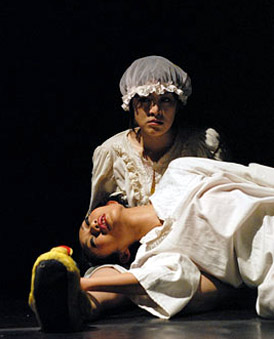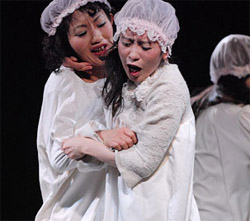Dec 24, 2025
Dec 24, 2025
 "I hoped to get rid of any meanings, prejudice or value attached to the body of a woman. But thinking about and working with the woman's body leads to a kind of contradiction. In my attempt to break prejudices, I had to first confront and work with them."
"I hoped to get rid of any meanings, prejudice or value attached to the body of a woman. But thinking about and working with the woman's body leads to a kind of contradiction. In my attempt to break prejudices, I had to first confront and work with them."
With these words, Shirotama Hitsujiya, 38, Tokyo-based performance artist, reflects upon her new performance 'Candies Girlish Hardcore', which premiered at Cardiff's Chapter Arts Centre recently. The show, which will now travel to London's Institute of Contemporary Arts and later in the year to New York, is an hour-and-a-half-long rendition around the body of the contemporary woman. In the process, the piece evokes history, memory, popular culture and pastiche alongside some rather quiet and meditative moments of introspection.
Strong, bold yet poetic, this piece speaks a hybrid language in which popular and folk culture, deep introspection - and the very urban spirit of 'anything goes' - interact. Hitsujiya, who is deeply interested in inter-culturalism, holds that Asian societies have been particularly bent towards cross-cultural exchange that can be testified historically.
In 'Candies Girlish Hardcore', inter-culturalism is more than an aesthetic. It is a means for universalizing and confronting the issues embedded in the body of the woman. 'Candies Girlish Hardcore' is performed by five women artists who come from varying performance idioms, including striptease.
In the performance, the scenes involving the female nude are most profound, wherein we encounter the performers stripping to reveal tattooed bodies. Their nudity is, however, not nakedness. The nude bodies are not exhibitionist or purely sensual. Extremely dignified and contained, the viewer is robbed of any preconceived notions s/he may have towards the female nude, sensing in the act an urge for utterance and voice, that is as angry as it is intimate.
Every performer's relationship to and inhabitation of her body is subtle and delicate. While there is no dialogue or speech in these moments, the tattoos become a means of voice. The tattoos are variegated; some include Sanskrit or Buddhist symbology. Here, one is reminded of New York-based Iranian artist Shirin Neshat's famous photographic series 'Women of Allah (1993-97)', in which armaments and calligraphy inscribed on the body of the Islamic, veiled woman became a poetic gesture to shatter silence. In 'Candies Girlish Hardcore', the women use and work with their bodies to acknowledge the testimonials of time, history and social conditioning.
The piece is composed of intense sequences of abstract movements, interspersed with dialogue that at first appears as wayside, casual and personal. Through consistent repetition, however, it assumes the weight of wider social and cultural connotations. Repetition is an aesthetic and one can also gather that it has been central to the process of developing the performance. Hitsujiya explains, "I wanted to make the body of the performer bored with movement. And then I wanted to observe the difference between a bored body and a bored mind."
Both dialogue and body movements are performed through sustained repetition. This is physically stressful for the performer. It is also demanding for the viewer, pressing upon his/her concentration. But what this aesthetic strategy achieves is that it propels the performance as not linear but composed of multiple layers. Further, it immerses the audience in the organic evolution of the performance.
This contrasts sharply with modes of dramatization that assert sharp variations of mood, emotion and movement in other cultural contexts, like in the traditions of European drama. In theatre, in fact, the usual technique is to use two contrasting characters or emotions to create a dramatic effect.
Hitsujiya says that the motivation for 'Candies Girlish Hardcore' was, for one, a reflection upon Japan's steadily expanding aged population, and two, the concern for what kind of women "we should be in 50 years", a concern she shares with her performers.
 History can, therefore, not be separated from the work. Forces of urbanization and modernization, Japan's own status after World War II and the contemporary world scenario in which terror comes to play globally, indicate for Hitsujiya how human beings are becoming distanced from nature. "I have only read about the atomic bombing of Hiroshima and Nagasaki in school textbooks. But I was in New York on September 11 (terrorist attack on the US in 2001). I share in that experience and through that the bombings of World War II."
History can, therefore, not be separated from the work. Forces of urbanization and modernization, Japan's own status after World War II and the contemporary world scenario in which terror comes to play globally, indicate for Hitsujiya how human beings are becoming distanced from nature. "I have only read about the atomic bombing of Hiroshima and Nagasaki in school textbooks. But I was in New York on September 11 (terrorist attack on the US in 2001). I share in that experience and through that the bombings of World War II."
In the performance itself, we also clearly sense women's urge to connect with one another. There is an ecological proclivity in the piece.
The performers tread a very fine territory; immersed within themselves and interacting with other performers. An individuality and a relational dynamic surface at once in the piece. This invites interest into how the piece has been developed and how far the performers are personally embedded in it.
Hitsujiya notes that 'Candies Girlish Hardcore' took longer to put together than her average show. It has now been in development for almost a year. "It is multi-layered," she says, explaining that the show was developed by the performers and herself, and is not her vision alone. For instance, "I first scripted a dance sequence bearing in mind the costume - black skirts. When I introduced it to the performers, they imagined and made associations around it. That is how certain body poses, which the performers imagined, were introduced into it. And thus the sequence became more than just dance. And more than just directed by myself."
Hitsujiya's company Yubiwa Hotel is today a key force in Tokyo's alternative theatre scene. A conglomerate of women artists, Yubiwa Hotel is a space for serious reflection upon women in contemporary society. 'Candies Girlish Hardcore' articulates concerns that may have arisen in the immediate Japanese context but are more universal, shared by women of differing backgrounds.
The formal, abstract and minimal vocabulary of the piece facilitates this. Themes of returning to childhood, meditation and prayer, familial relations, women's single-hood, either as spinsters or widows, are numerous moods evoked in show. The piece is both a reflection upon existing circumstance, and a utopian, shared imagination where women connect before any definitions or social conditions divide or distance them. The aesthetics of the piece cannot be easily categorized in keeping with any tradition. They are contingent on the thought behind the piece. In this measure, the piece very powerfully transcends barriers and distinctions of culture and language.
19-Feb-2006
More by : Aparna Sharma